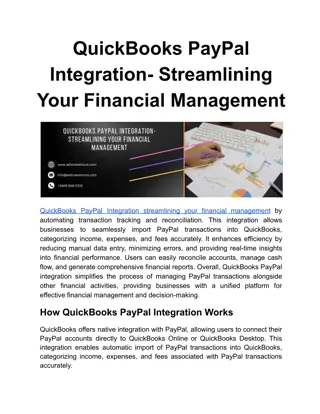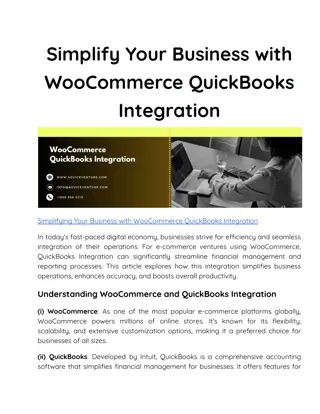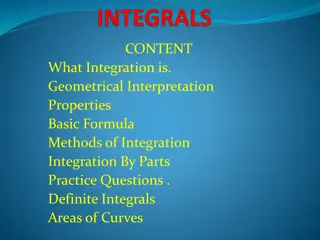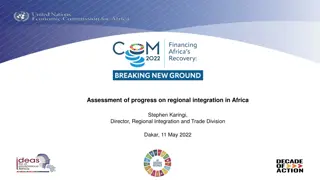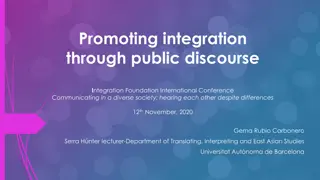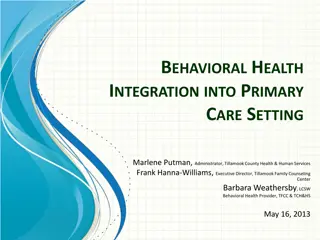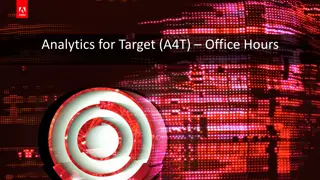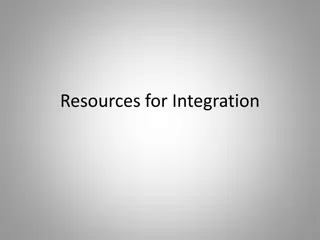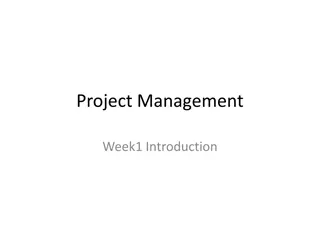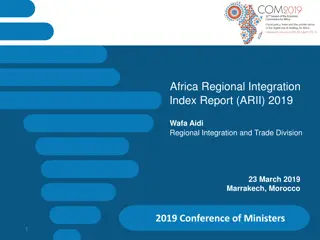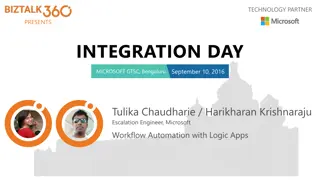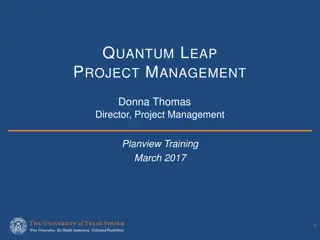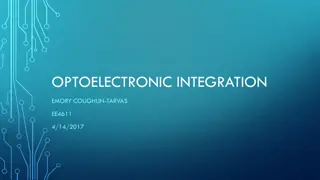Comprehensive Guide to Project Integration Management
Understanding Project Integration Management is crucial for project managers to oversee all aspects of a project effectively. This guide covers the key concepts, processes, and knowledge areas related to integration management, providing insights into coordinating different project elements for successful outcomes.
Download Presentation

Please find below an Image/Link to download the presentation.
The content on the website is provided AS IS for your information and personal use only. It may not be sold, licensed, or shared on other websites without obtaining consent from the author.If you encounter any issues during the download, it is possible that the publisher has removed the file from their server.
You are allowed to download the files provided on this website for personal or commercial use, subject to the condition that they are used lawfully. All files are the property of their respective owners.
The content on the website is provided AS IS for your information and personal use only. It may not be sold, licensed, or shared on other websites without obtaining consent from the author.
E N D
Presentation Transcript
4 Project Integration Management By: A. Shukr, M. Alnouri
Project integration management Intro Many new project managers have trouble looking at the big picture and want to focus on too many details. Project managers must coordinate all of the other knowledge areas throughout a project s life cycle.
Project integration management Intro Understanding the Integration Management processes will give you a great tool set for overseeing the big-picture throughout your projects. Integration Management is about seeing the forest through the trees coordinating your many documents and resources to ensure deliverables are on time and within budget prior to closing the project.
Project integration management Intro What is Project Integration Management? Project IntegrationManagement Project Management Process Groups Project Integration Management includes the processes activities needed to: Identify Define Combine Unify Coordinate Various processes and project management activities within the Project Process Groups. and Identify Define Combine Unify Coordinate Processes & activities Management
Project integration management Body of Knowledge Over the last two decades, there has been much study and discussion on the contents of the project management process. Currently, the Project Management Institute has identified nine major elements forming the Project Management Body of Knowledge...
Project integration management Body of Knowledge Four core knowledge areaslead to specific project objectives: Scope Quality Time Cost Four facilitating knowledge areasare the means through which the project objectives are achieved: Human resources Contract/procurement Information/communications One knowledge areaaffects and is affected by all of the other knowledge areas: project integration management
Project integration management Body of Knowledge
Project integration management Body of Knowledge All knowledge areas are important!
Project integration management Processes Project integration management is primarily concerned with integrating processes to accomplish project objectives. Project Integration Management includes the processes required to ensure that the various elements of the project are properly coordinated. It involves making tradeoffs among competing objectives and alternatives in order to meet or exceed stake-holder needs and expectations.
Project integration management Processes The seven processes in the Project Integration Management knowledge area work in concert to facilitate proper project coordination. The project integration requires each process seamlessly links and fuels the next process.
Project integration management Processes Develop the Project Management Plan Direct and Manage Project Execution Develop Project Charter Monitor and Control Project Work Integrated Change Control Close Project
Project integration management Processes 1. Develop Project Charter Develop the Project charter is initiating the project. The derived project charter approves and sanctions the project. Gives the project manager the authority to act and apply organizational resources to the project. Key project stakeholders should sign a project charter to acknowledge agreement on the need and intent of the project. a signed charter is a key output of project integration management.
Project integration management Processes 2. Develop the Project Management Plan Developing the Project Management Plan includes all activities needed to create and integrate all subsidiary plans into the Project Management Plan. This plan will be how the project is: executed managed monitored Plans created in the other knowledge areas are subsidiary parts of the overall project management plan.
Project integration management Processes 2. Develop the Project Management Plan Common Elements of a Project Management Plan: Introduction or overview of the project. Description of how the project is organized. Management and technical processes used on the project. Work to be done, schedule, and budget information.
Project integration management Processes 3. Direct and Manage Project Execution Directing and Managing Project execution is orchestrating how the project team performs the actions to implement the Project Management Plan and complete the work detailed in the Project Scope Statement.
Project integration management Processes 4. Monitor and Control Project Work Monitoring and Controlling Project work measures and balance the projects progress and any corrective or preventative actions needed to assure all project objectives are met. Changes are inevitable on most projects, so it s important to develop and follow a process to monitor and control changes. Monitoring project work includes collecting, measuring, and disseminating performance information. Two important outputs of monitoring and controlling project work include recommended corrective and preventive actions.
Project integration management Processes 5. Integrated Change Control Integrated Change Control is the change control process for the project which includes: Evaluating all change requests Authorizing changes managing changes to project plans and deliverables The key benefit to this process is that only validated approved changes are implemented.
Project integration management Processes 5. Integrated Change Control Three main objectives: Influence the factors that create changes to ensure that changes are beneficial. Determine that a change has occurred. Manage actual changes as they occur. A baseline is the approved project management plan plus approved changes.
Project integration management Processes 5. Integrated Change Control
Project integration management Processes 5. Integrated Change Control Suggestions for Managing Integrated Change Control: View project management as a process of constant communication and negotiation. Plan for change. Establish a formal change control system, including a change control board (CCB). Use good configuration management. Define procedures for making timely decisions on smaller changes. Use written and oral performance reports to help identify and manage change. Use project management and other software to help manage and communicate changes.
Project integration management Processes 6. Close Project To close a project, you must finalize all activities and transfer the completed or cancelled work to the appropriate people. Closing the project equates to: Completing all project activities Delivering the final project Turning over continual support to operations Obtaining the client approval to formally close the project
Project integration management Project process groups The project process groups overlap, interact, and directly affect one another as they all play out the greater project plan. Initiating Process Group Planning Process Group These interactions create project management synchronization. Executing Process Group Monitoring and Controlling Process Group All project management processes are divided into the following five project process groups: Closing Process Group
Project integration management Project process groups The Initiating Process Group includes those processes necessary for formally authorizing the beginning of a new project. The processes for developing the Project Charter and developing the preliminary Project Scope Statement occur in the Initiating Process Group. Initiating The Planning Process Group includes those processes that establish the project scope, create the Project Management Plan, and identify and schedule the project activities. The process for developing the Project Management Plan occurs in the Planning Process Group. Planning
Project integration management Project process groups The Executing Process Group consists of those processes necessary for completing the work outlined in the Project Management Plan to achieve the project's objectives. The process for directing and managing project execution, which ensures that the Project Management Plan is implemented properly, occurs in the Executing Process Group. Executing The Monitoring and Controlling Process Group is necessary for gathering, assessing, and distributing performance information and analyzing measurements and trends to make continual process improvements. The processes for monitoring and controlling project work and implementing integrated change control occur in the Monitoring and Controlling Process Group. Monitoring &Controlling The Closing Process group consists of those processes necessary for officially ending project activities and handing off the completed product to others. This also includes closing a project that has been canceled. Closing
Project integration management Overview
Project integration management Companies that excel in project delivery capability: Build an integrated project management toolbox (use standard/advanced PM tools, lots of templates) Grow competent project leaders, emphasizing business and soft skills Develop streamlined, consistent project delivery processes Install a sound but comprehensive set of project performance metrics
Project integration management Focus on pulling everything together to reach project success!
Project integration management Summary Project integration management includes: Developing a project charter. Developing a preliminary project scope statement. Developing a project management plan. Directing and managing project execution. Monitoring and controlling project work. Performing integrated change control. Closing the project.









